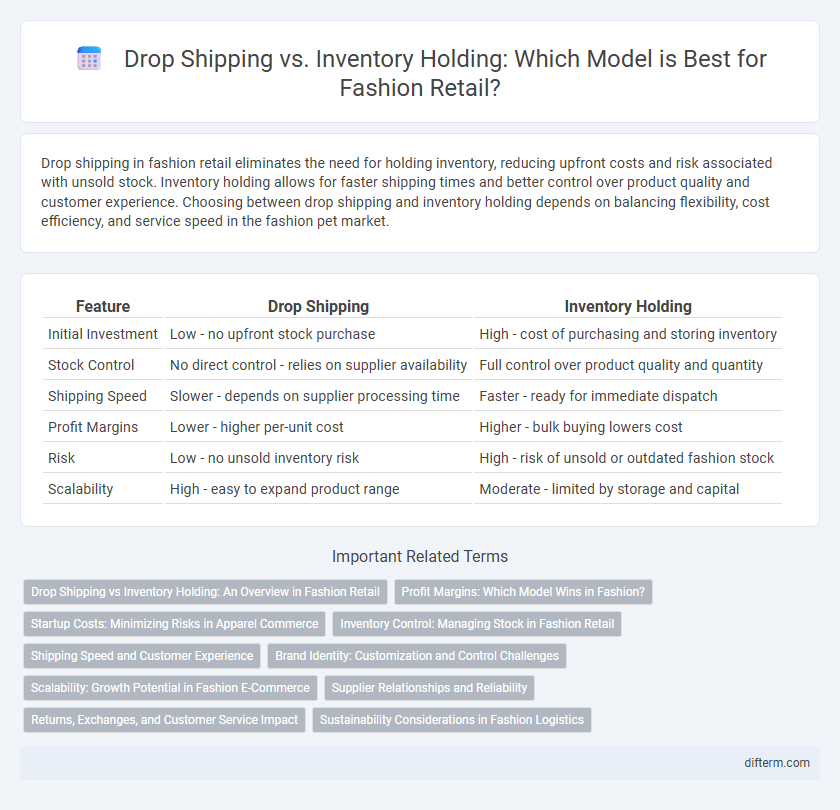Drop shipping in fashion retail eliminates the need for holding inventory, reducing upfront costs and risk associated with unsold stock. Inventory holding allows for faster shipping times and better control over product quality and customer experience. Choosing between drop shipping and inventory holding depends on balancing flexibility, cost efficiency, and service speed in the fashion pet market.
Table of Comparison
| Feature | Drop Shipping | Inventory Holding |
|---|---|---|
| Initial Investment | Low - no upfront stock purchase | High - cost of purchasing and storing inventory |
| Stock Control | No direct control - relies on supplier availability | Full control over product quality and quantity |
| Shipping Speed | Slower - depends on supplier processing time | Faster - ready for immediate dispatch |
| Profit Margins | Lower - higher per-unit cost | Higher - bulk buying lowers cost |
| Risk | Low - no unsold inventory risk | High - risk of unsold or outdated fashion stock |
| Scalability | High - easy to expand product range | Moderate - limited by storage and capital |
Drop Shipping vs Inventory Holding: An Overview in Fashion Retail
Drop shipping in fashion retail enables brands to sell products without holding physical inventory, reducing upfront costs and minimizing risk by directly shipping from suppliers to customers. Inventory holding requires retailers to stock merchandise, offering greater control over product quality, faster delivery times, and enhanced customer experience but involves higher capital investment. Choosing between drop shipping and inventory holding depends on factors like product variety, cash flow, scalability, and customer service priorities in fashion retail operations.
Profit Margins: Which Model Wins in Fashion?
Drop shipping in fashion retail often yields lower profit margins due to third-party fees and limited control over pricing, whereas inventory holding allows brands to maximize margins by purchasing in bulk and directly managing costs. Inventory holding enables exclusive product customization and faster fulfillment, boosting customer satisfaction and repeat sales that contribute to stronger profitability. Despite higher upfront costs, inventory holding typically generates higher long-term profits compared to drop shipping's lower margin but reduced operational risk.
Startup Costs: Minimizing Risks in Apparel Commerce
Drop shipping significantly reduces startup costs in fashion retail by eliminating the need for upfront inventory investment, allowing entrepreneurs to launch stores with minimal financial risk. Inventory holding requires substantial capital to purchase and store apparel stock, increasing the risk of unsold merchandise and cash flow challenges. Fashion startups favor drop shipping to minimize overhead expenses and focus resources on marketing and customer acquisition.
Inventory Control: Managing Stock in Fashion Retail
Effective inventory control in fashion retail balances stock availability with minimizing overstock risks to optimize cash flow and reduce markdown losses. Drop shipping eliminates the need for physical stock management by directly shipping products from suppliers, which reduces holding costs and inventory obsolescence but may compromise order fulfillment speed and quality control. Inventory holding allows for tighter control over stock levels, enabling faster delivery and personalized customer experience, but requires advanced forecasting and warehouse management to prevent excess inventory and stockouts.
Shipping Speed and Customer Experience
Drop shipping in fashion retail offers slower shipping speeds compared to inventory holding, as products are shipped directly from suppliers, leading to longer delivery times. Inventory holding ensures faster shipping by storing products locally, enhancing customer satisfaction through quicker order fulfillment. Faster delivery improves the overall customer experience, increasing repeat purchases and brand loyalty in the competitive fashion market.
Brand Identity: Customization and Control Challenges
Drop shipping in fashion retail offers limited customization options, often resulting in weaker brand identity due to reliance on third-party suppliers. Inventory holding enables greater control over product quality, packaging, and exclusive designs, strengthening brand differentiation. However, managing stock requires significant investment and logistical effort, impacting operational agility.
Scalability: Growth Potential in Fashion E-Commerce
Drop shipping enables rapid scalability in fashion e-commerce by eliminating inventory constraints and reducing upfront capital investment, allowing retailers to quickly expand product offerings and test new trends with minimal risk. Conversely, inventory holding requires significant storage and management resources, which can limit growth potential but provides greater control over product quality and fulfillment speed. Fashion retailers seeking aggressive growth often favor drop shipping for its flexibility, while those prioritizing brand control may opt for inventory holding despite slower scalability.
Supplier Relationships and Reliability
Strong supplier relationships are critical in dropshipping for fashion retail, as retailers rely heavily on suppliers' timely order fulfillment and product quality, which directly impacts customer satisfaction. Inventory holding allows retailers to maintain control over stock quality and availability, enhancing reliability through direct oversight of supplier shipments and storage conditions. Both models demand robust communication and trust with suppliers, but inventory holding offers greater assurance in managing product consistency and delivery timelines.
Returns, Exchanges, and Customer Service Impact
Drop shipping in fashion retail reduces inventory costs but often complicates returns and exchanges, leading to longer processing times and potential customer dissatisfaction. Inventory holding allows for quicker returns and exchanges due to direct product control, enhancing customer service responsiveness and satisfaction. Efficient management of returns and exchanges is critical in fashion, where fit and style preferences drive high return rates impacting overall customer experience.
Sustainability Considerations in Fashion Logistics
Drop shipping in fashion retail reduces waste and lowers carbon emissions by minimizing overstock and eliminating the need for large warehouse spaces. Inventory holding often leads to excess unsold products, contributing to environmental pollution through textile waste and higher energy consumption for storage. Sustainable logistics prioritize efficient supply chains, favoring drop shipping models to decrease the fashion industry's ecological footprint.
Drop shipping vs Inventory holding (fashion retail) Infographic

 difterm.com
difterm.com